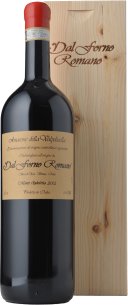Laurent Ponsot Grand Cru Cuvée du Cèdre
Cuvée du Cèdre Clos de Vougeot A blend of fruit from propitiously situated plots, sourced from six different growers, across the largest of all of Burgundys Grand Crus. Intentionally, some are prime real estate, directly behind the château; others, on the lower ebbs of the vineyard. Ponsot sees this as a balancing act. A wealth of black cherry, red currant and plum liqueur, framed by the Clos earthenware tannins. A wine that is consistently rated frumps by the worlds eminent Burgundy commentators, this will only grow in stature with extended patience.
Guigal La Turque Côte Rôtie
The 2001 La Turque is a vineyard-designated wine from a parcel inside the lieu-dit Côte Brune. It is a blend of 93% Syrah and 7% Vigonier. Meaty and rich, laced with Asian spice, espresso, blackberries, and cherry. An earthy, powerful, tannic wine with a long, heady, rich finish. Give it at lease 2-5 years in the cellar, and drink before 2040. One of the finest wines in Dan Murphy's Cellar Release Range.
Guigal La Mouline Côte Rôtie
Guigal are one of the cornerstones of the Côte Rôtie appellation after Etienne Guigal founded the estate in 1946, tending vines that have produced world class wines for over 2,000 years. The 2005 Côte Rôtie is a blend of 89% Syrah and 11% Viognier is a truly remarkable wine from vintage that was considered difficult by many. That is impossible to tell when enjoying a bottle of this 100 Robert Parker pointed Côte Rôtie that is voluptuous and complex. Still tightly wound and a little shy, the 2005 will age easily for 20+ years which should be considered mandatory.
Chris Ringland Dry Grown Shiraz
The Chris Ringland Dry Grown Shiraz 2007 smells of mineral oil, leaf litter, stones and dust. Despite it's weight and density, it is lively and vivid. This is a very powerful Shiraz with great structure, it could be cellared for 20-30 years and mature gracefully.
Bass Phillip Reserve Pinot Noir
Australian Pinot Noir does not get any better than the wines produced by Phillip Jones at the iconic Bass Phillip winery. A Pinot Noir of utmoust power and elegance, the rival to any great Burgundy. Rated in the top classification in Langton's Classification of Australian Wine, Bass Phillip Pinot Noir is riddled with complex flavours of strawberry, violets, rose petal and forest floor. The length of palate is immortal.
Château Mouton Rothschild Pauillac
Château Mouton Rothschild is the work of one man, the legendary Baron Philippe, who is solely responsible for this giant of Bordeaux. Taking charge in 1923 until his death in 1988, he created something the world will always be in debt for. He also started the tradition of getting an artist to design a label for every vintage, a tradition that continues to this day. In 2009, the wine almost transcends perfection. A quite low alcohol percentage given the ripeness of the fruit, the bouquet is reminiscent of cigar box and graphite with violets and cassis playing a part. The palate is both restrained and concentrated, a impressive result indeed. The structure of the wine is hidden somewhat by the exuberant fruit, yet it is that structure that will see this extraordinary wine cellar for the good part of half a century!
Château Cheval Blanc Saint-Émilion
Without a doubt one of Bordeaux's most famous vineyards, Cheval Blanc lies on the border of Pomerol and is also easily the most important estate in St-Émilion. Uniquely a blend dominated by Cabernet Franc, Cheval Blanc's wines have a powerful bouquet which is spicy and rich which is followed by fruit that is soft, mellow and liquorous. Matched only by Pétrus in the realm of vigour and concentration, Cheval's exuberance is not to be missed. With this latest release, the 2009, the wines are bordering on immortal. A blend of 60% Merlot and 40% Cabernet Franc, this super-smooth, velour textured and opulent red wine shows rambunctious flavours of raspberries, blueberries, liquorice and a smidge of menthol. Will be fascinating to watch this
Dal Forno Romano
Chris Ringland Dry Grown Barossa Ranges Shiraz
Chris Ringland's Barossa Ranges Shiraz is steeped in the Barossas post-colonial story and the high art and science of winemaking. Typically deep in colour with intense dark berry, paneforte, espresso roasted chestnut aromas, it displays a plush and concentrated palate with blackberry, mocha, paneforte spicy flavours and dense fine chocolaty tannins. Despite the opulence, flamboyance, richness and concentration, the wine has superb percussion and freshness. The wine is a small vinification of around four to five hogsheads or 1500 litres. The "unusually thick skinned" Shiraz is entirely sourced from Chris Ringland's dry-grown vineyard on the edge of the Barossa Valley, but technically in Eden Valley, along Flaxman's Valley near Randall's Hill. The wine is "painstakingly hand-made" in open fermenters and regularly pumped-over to extract colour, flavour and tannins. After draining and pressing through a traditional basket press, fermentation is completed in 100% new French oak hogsheads. A period of up to 50 months oak maturation follows to achieve optimum complexity and balance between oak and fruit. The extraordinarily high release prices (higher than Penfolds Grange), limited production and reputation make Chris Ringland Barossa Ranges Shiraz the stuff of legend.























